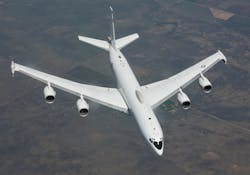Navy picks Collins Aerospace to provide Very Low Frequency (VLF) command-and-control for nuclear forces
PATUXENT RIVER NAS, Md. – U.S. nuclear command-and-control experts needed a means to communicate with submerged nuclear ballistic missile submarines and with national command authorities in wartime. They found their solution from Collins Aerospace in Cedar Rapids, Iowa.
Officials of the U.S. Naval Air Systems Command at Patuxent River Naval Air Station, Md., announced a $13.5 million order Thursday to Collins Aerospace, a Raytheon Technologies company, for two modernized Very Low Frequency (VLF) High Power Transmit Set production kits for the E-6B Mercury aircraft.
The E-6B Mercury is a modified Boeing 707 jetliner serves as a backup to the U.S. Strategic Command Global Operations Center should the ground-based site be unable to fulfill its mission. The order includes 63 spares, 10 production support assets, and technical data.
VLF communications are among the most durable and reliable communications modes for military use. Although VLF sends data relatively slowly, it is designed to survive and operate through nuclear explosions.
Command authorities also communicate with submerged submarines using the Take Charge and Move Out (TACAMO) aircraft, which uses a long trailing-wire antenna to transmit messages to submerged submarines.
VLF radios transmit a 50 baud submarine command-and-control broadcast which is the backbone of the submarine broadcast system, Navy officials say.
VLF radio signals provide good performance in atmospheric noise, global coverage, and seawater-penetrating properties. The submarine VLF broadcasts operates frequencies from 14 to 60 kHz and consist of high-powered multi-channel MSK Fixed VLF sites and multi-channel LF sites located at 10 sites worldwide.
The E-6B Mercury has a crew of 22, including pilots, communications operators, and battle staff personnel. The aircraft is designed to be a versatile command-and control aircraft in times of nuclear confrontation.
Acting as the Airborne Command Post, it can serve as the Airborne Launch Control System with its ability to communicate launch codes directly to land-based ICBM sites. The E-6B aircraft could command ICBM launch if the launch control centers are unable to perform their missions.
The E-6B, in addition to its ability to communicate with land-based ICBM sites, also can communicate with deployed U.S. Navy ballistic missile submarines in the aircraft's additional role as the Take Charge and Move Out (TACAMO) communications relay.
As the TACAMO aircraft, the E-6B can deploy a 2.5-mile trailing wire antenna to give orders to submerged submarines over the vessels' very-low-frequency/low-frequency (VLF/LF) communications systems, which can receive information through the water at very slow data rates.
The E-6B aircraft also can communicate over UHF and EHF military satellite links. The E-6B fleet is based at Tinker Air Force Base, Oklahoma.
On this order Collins Aerospace will do the work in Richardson, Texas, and should be finished by December 2023. For more information contact Collins Aerospace online at www.collinsaerospace.com, or Naval Air Systems Command at www.navair.navy.mil.
About the Author
John Keller
Editor-in-Chief
John Keller is the Editor-in-Chief, Military & Aerospace Electronics Magazine--provides extensive coverage and analysis of enabling electronics and optoelectronic technologies in military, space and commercial aviation applications. John has been a member of the Military & Aerospace Electronics staff since 1989 and chief editor since 1995.
